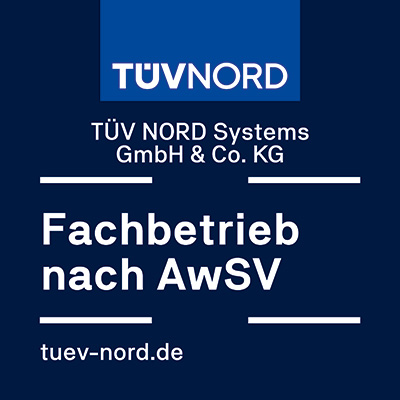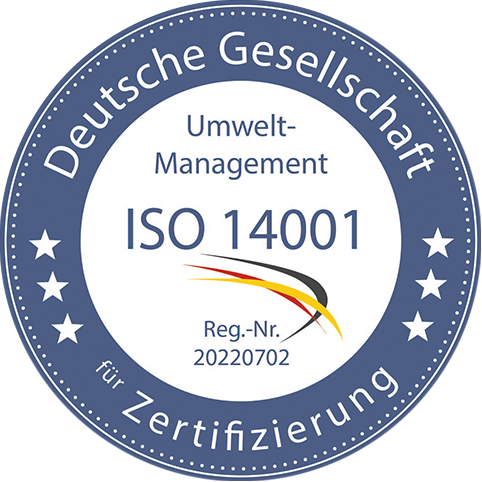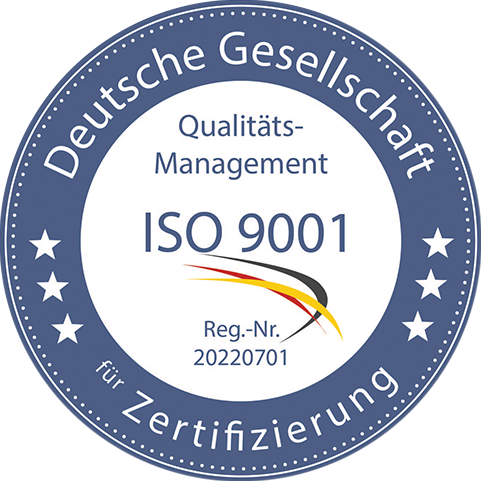We bring
Light into the darkness!
The following legal bases must be observed in the order in which they appear:
- European law (European Water Framework Directive and its daughter directive on water protection)
- National law (WHG – Water Resources Act)
- Federal Ordinance on Installations for Handling Substances Hazardous to Water (AwSV)
Requirements according to the Federal Water Act (WHG)
In principle, facilities for handling substances hazardous to water must be constructed and operated in such a way that “there is no reason to fear any detrimental change in the properties of water bodies”, without exception, i.e. “free quantities” are not permitted (Water Resources Act § 62).
This so-called “principle of concern” states that there must be no probability, however remote, of contamination of the water. The occurrence of damage must be unlikely according to human judgment.
Requirements according to WHG Water Resources Act (principle of concern § 62 WHG)
In principle, facilities for handling substances hazardous to water must be constructed and operated in such a way that “there is no reason to fearany detrimental change in the properties of water bodies”.
This applies without exception, i.e. “free quantities” are not given (Water Resources Act § 62).
“Country-specific deviations from this principle are generally not possible.”
This so-called “principle of concern” states that there must be no probability, however remote, of contamination of the water. The occurrence of damage must be unlikely according to human judgment.
In order to achieve the protection target, a safety concept must be drawn up for each system, which must basically contain requirements from the following four areas:
- General safety (primary safety) Suitability and reliability of all system components against all loads and effects
- Multiple security (secondary security) redundant technical protective measures
- Internal and external monitoring (tertiary safety)
- Reparative measures (quaternary safety) Possibilities and prospects of success in the event of damage
This is associated with an obligation to provide information during the construction of systems, which must be provided by the specialist planner and system builder (Water Resources Act § 5 General Duty of Care).
The Ordinance on Installations for the Handling of Substances Hazardous to Water (AwSV) was published on April 21, 2017. This means that the previous 16 state regulations (VAwS) will be replaced by the nationwide ordinance from August 1, 2017.
§ 1 Purpose; scope of application
(3) This Ordinance shall also not apply to above-ground installations with a volume of no more than 0.22 cubic meters for liquid substances or with a mass of no more than 0.2 tons for gaseous and solid substances if these installations are located outside protected areas and designated or provisionally secured floodplains. § Section 62 (1) and (2) of the Federal Water Act remains unaffected.
And thus remain subject to the principle of concern (§62 para. 1 WHG).
§Section 1 (1) defines the purpose of the Ordinance, namely the protection of water bodies from adverse changes in their properties due to the release of substances hazardous to water from installations handling such substances. Experience has shown that without appropriate regulations, there is considerable contamination of soil and groundwater. This regulation is intended to prevent these effects. The prerequisite for an operator to apply the ordinance is that he operates a plant and that substances hazardous to water are handled in this plant. A facility in which the operator handles a substance hazardous to water must be constructed and operated in accordance with the principle of concern set out in Section 62 (1) WHG in such a way that, based on human experience, it is unlikely that these substances hazardous to water will enter the soil or water bodies.
§ 19 Drainage requirements
(1) In the event of unavoidable ingress of precipitation water, drains are permitted in deviation from Section 18 (2) if they are only opened after prior determination that the precipitation water does not contain any substances hazardous to water. Precipitation water contaminated with substances hazardous to water must be properly
disposed of as waste water or waste.
(4) Precipitation water from areas on which cooling units of refrigeration systems with ethylene or propylene glycol are installed outdoors must be discharged into a wastewater or combined sewer. Water law requirements for the discharge and local discharge conditions remain unaffected.
Again, a little more precise:
AwSV § 1 Purpose; scope of application
… “(3) This Ordinance shall also not apply to above-ground installations with a volume of no more than 0.22 cubic meters for liquid substances or with a mass of no more than 0.2 tons for gaseous and solid substances if these installations are located outside protected areas and designated or provisionally secured floodplains. § Section 62 (1) and (2) of the Federal Water Act remains unaffected. Installations according to sentence 1 do not require a suitability assessment according to § 63 paragraph 1 of the Federal Water Act”
Paragraph 3 introduces a de minimis regulation with the aim of reducing bureaucracy. Above-ground systems up to 220 liters or 200 kilograms outside of protected areas and designated or provisionally secured floodplains are exempt from the ordinance. The technical requirements, notification obligations or other obligations under this Ordinance therefore do not apply to the operators of these installations.
For these installations, however, the principle of concern or the principle of best possible water protection pursuant to Section 62 (1) WHG remains unaffected in accordance with sentence 2, even if no special technical and organizational measures are required under the Ordinance. This de minimis regulation also does not mean that the stated quantities are insignificant. The release of a substance hazardous to water from a small installation is just as significant as the release of the same quantity from an installation that is subject to the Ordinance. According to sentence 3, the aforementioned small installations also do not require a suitability assessment pursuant to Section 63 (1) WHG. The introduction of such a de minimis regulation follows the frequently expressed wish to dispense with any kind of official control for such installations and to leave compliance with the principle of concern or the best possible protection of water bodies to the operators’ own responsibility. The de minimis regulation also relieves the responsible authorities of any control work, unless there is a leak of water-polluting substances or soil or water pollution.
What happens if damage occurs?
In the event of environmental damage, the Environmental Damage Act and the Environmental Liability Act apply. The operator is fully liable for damage caused by its systems, without any maximum liability limits. Insurance companies are only liable in the event of damage if the system was planned, installed and operated in accordance with legal requirements. An official permit does not protect the operator from punishment; companies are liable for officially approved activities. Of course, the operator can make recourse claims against third parties who have been entrusted with the professional planning and execution as a specialist company or specialist planner.
Non-compliance with the WHG is also subject to a fine and amounts to a maximum of EUR 50,000 – if damage occurs because the operator has not taken safety precautions for his machines for cost reasons, further costs such as cleaning the soil and replacing the ecological compensation will be added.
Handling substances hazardous to water
The protection of water bodies is essential for the health of the population, for the preservation of natural resources and as a prerequisite for economic development. To this end, water bodies must be safeguarded as part of the ecosystem and as a habitat for animals and plants, and managed in such a way that they serve the common good and, in harmony with this, also the benefit of individuals, and that avoidable impairment of their ecological functions is avoided.
One of the key instruments of the precautionary principle is to prevent water-polluting substances from leaking from installations and causing pollution in surface waters and groundwater. It is not just about spectacular damage such as the fire at the Sandoz company in Basel, fish kills or impairments to the drinking water supply, but also about damage to aquatic organisms such as algae or small crustaceans that is not visible at first glance.
What are substances hazardous to water?
Substances hazardous to water are defined by their physical, chemical, human and ecotoxicological properties and lead to adverse changes in water quality. These include the majority of substances that are handled in industry and commerce, but also in the private sector, e.g. oils, fuels, solvents, acids, alkalis or salts.
As a measure of their water hazard, they are classified into three water hazard classes (WGK) according to the assessment scheme of the administrative regulation on the classification of substances hazardous to water:
- WGK 1: slightly hazardous to water (e.g. acetic acid, caustic soda, alcohol or iodine)
- WGK 2: hazardous to water (e.g. heating oil, formaldehyde, sodium hypochlorite)
- WGK 3: highly hazardous to water (e.g. waste oil, chlorinated hydrocarbons, benzene)
The classification forms the basis for graduated safety requirements for the systems and must be carried out by the operator if a substance hazardous to water has not yet been classified. You can find out which substance has already been classified via the administrative regulation or on the Internet at webrigoletto.uba.de.
Legal basis and responsibilities
The principle of concern and the basic operator obligations can be found in Sections 62 and 63 of the Water Resources Act. The specific technical design and the corresponding obligations, including the necessary notification and suitability assessment procedures, are laid down in the ordinances on installations for handling substances hazardous to water (VAwS) of the federal states.
Since the federalism reform of 2006, the federal government has had extended legislative powers, which allow for a federal ordinance and are resistant to deviations in substance and plant-related regulations. The draft of this regulation has been available since the end of 2010. The ordinance is expected to be issued in the first quarter of 2014. Until then, the ordinances of the federal states and the transitional ordinance (PDF, external, 33 KB) will continue to apply.
Regulations on technical installations
The Water Resources Act (WHG) defines the nationwide standard that facilities (e.g. oil tanks, filling stations, storage facilities or distillation plants) must meet. According to the so-called principle of concern in Section 62 (1) WHG, facilities for handling substances hazardous to water must be designed, constructed, maintained, operated and decommissioned in such a way that there is no reason to fear any detrimental change in the properties of water bodies. This is the case if primary and secondary safety measures have been taken and the operator fulfills certain obligations and provides for monitoring measures.
Primary safety ensures that the systems and system components in which the water-polluting substances are located are able to withstand the mechanical, chemical and thermal stresses. They must therefore be and remain leak-proof throughout the entire operating period so that no water-polluting substances leak out.
Secondary safety is a second safety barrier that prevents damage to the environment if the container or other system components fail. These include, in particular, drip pans or other containment devices that are independent of primary safety and that safely collect substances hazardous to water in the event of a leak without further human intervention.
Monitoring measures
Monitoring measures are used to determine whether the system is still tight and the safety devices are still functioning and are also intended to guarantee fast and reliable hazard detection and elimination. The operator himself is initially responsible for this, but he must also commission external experts to carry out a system inspection before commissioning a system and at regular intervals.
The generally recognized rules of technology must always be observed during the construction and operation of the systems (§ 62 para. 2 WHG). The generally accepted rules of technology (a.a.R.d.T.) are to be understood in particular as the principles and solutions laid down in technical standards and regulations that have been tested and proven in practice and are recognized by the majority of experts working in this field. The various parts of the Building Regulations List of the German Institute for Building Technology (DIBt) in particular apply as technical regulations. It lists construction products for stationary installations for the storage, filling and handling of substances hazardous to water, for which the requirements of water protection are also taken into account (for more details see www.dibt.de).
The generally recognized rules of technology also include the Technical Rules for Substances Hazardous to Water (TRwS) published by the German Association for Water, Wastewater and Waste (DWA) for certain systems (e.g. heating oil consumer systems) and construction methods (e.g. design of sealing surfaces) (for more information, see www.dwa.de).
Testing the systems
In addition to monitoring by the operator, a large proportion of the systems must be inspected by an external expert before commissioning and at regular intervals. These experts must belong to a recognized expert organization. If a defect is found in the system during these inspections, it must be rectified immediately.
Pipelines
Long-distance pipelines are pipelines in which water-polluting substances are transported and which cross several properties. These were previously also subject to the Water Resources Act, but were summarized together with other pipelines in the Environmental Impact Assessment Act (§§ 20 ff. in conjunction with No. 19.3 Annex 1, UVPG). The special technical and organizational requirements for these pipelines can be found in the Pipeline Ordinance. The Committee for Pipelines (AfR) has drawn up key documents in this regard. These can be found on the Internet at: www.bam.de.
Do it for yourself!
As the operator of a system, you are responsible for it. If one of the operator’s systems is responsible for environmental damage, the operator of the systems is liable to the full extent. Insurance companies are also not liable if your systems are not operated in accordance with the law.
Legally compliant operation requires, for example, that the system must be secured in such a way that its operation cannot have a negative impact on the environment.
Specialist companies responsible for planning, installation and maintenance have a duty to inform the operator. If this obligation to inform has not been fulfilled, the operator can hold the respective company liable.
The Water Resources Act (WHG) defines a maximum liability limit of EUR 50,000. This is comparable to a fine that must be paid as a penalty for the offense itself. In addition, however, there is now the removal of the damage and the neutralization of the environmental damage itself. The law does not provide for any maximum liability limits with regard to the repair of damage and can be really expensive.
Examples of costs for environmental damage:
- Removal and replacement of contaminated soil
- Resettlement of animal populations (land / river)
- Use of additional filter systems in sewage treatment plants (often for months)
- Claim for compensation for dead plants and trees
Obligations of industrial companies
Classification of substances hazardous to water
Installations for handling substances hazardous to water must be constructed and operated in such a way that no pollution or detrimental changes to water bodies occur. To this end, the substances used in the systems must be tested and classified for their water-polluting properties. All substances previously classified in a water hazard class or as non-water hazardous can be researched in the Federal Environment Agency’s online database Rigoletto.
The Administrative Regulation on Substances Hazardous to Water (VwVwS 1999 with supplementary VwVwS 2005) obliges the operators of systems for handling substances hazardous to water to classify the substances and mixtures they use into a water hazard class (WGK). The classifications of the substances must be documented at the Documentation and Information Center for Substances Hazardous to Water at the Federal Environment Agency.
At the Documentation and Information Center for Substances Hazardous to Water, the classification documentation of the operators is recorded, formally checked for plausibility and the resulting classifications of the substances are published on the Internet.
The staff of the Documentation and Information Center also answer inquiries: for example, on the classification procedure, on the formally and scientifically correct derivation of a WGK, on the interpretation of test results on water hazards and on specific substance classifications, and also provide assistance with the classification of mixtures.
The classifications of mixtures are not documented at the Federal Environment Agency, but must be made available to the competent enforcement authorities of the federal states. A form can be used for the documentation.
The criteria according to which the substances hazardous to water are classified as WGK 1, 2 or 3 or as not hazardous to water (nwg) are listed in Annex 3 of the VwVwS. An important difference to other classification systems is that substances that have not yet been sufficiently investigated, classified or identified are considered to be highly hazardous to water (WGK 3) as a precautionary measure.
Requirements for the facilities are then derived from the WGK and the tonnage of the water-polluting substances handled in the corresponding facility ordinances of the federal states. This is intended to rule out any risk to ground and surface waters when using the substances and in the event of accidents. In addition, the classification of substances into three water hazard classes or as non-hazardous to water provides a simple basis for decision-making for plant operators, local enforcement authorities and, in the event of an incident, for local fire departments. This is because they do not have to assess the relevance of all combinations of hazardous characteristics for water protection in detail. The WGK classification also creates an incentive to replace particularly hazardous or poorly investigated substances with substances that are less hazardous to water and have been well investigated.




